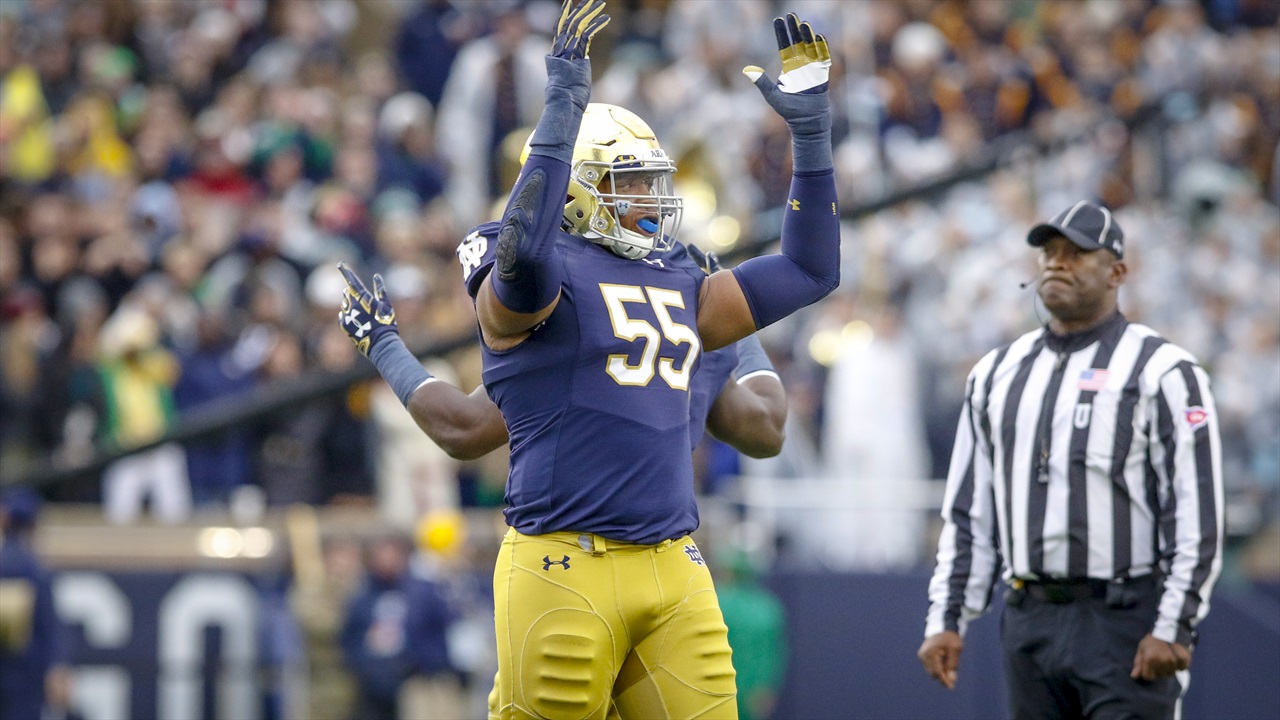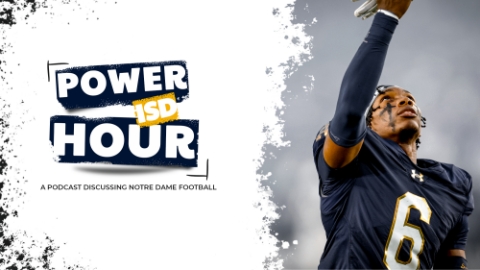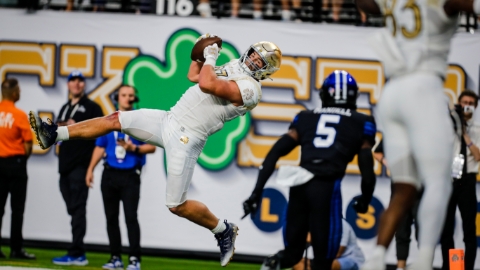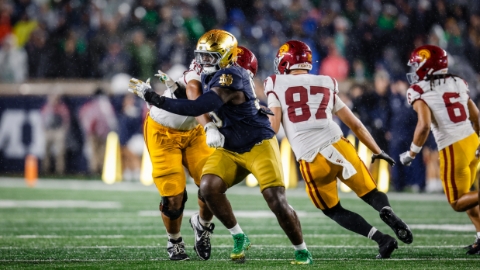
Notre Dame has recruited pretty well under Brian Kelly. Maybe not as well as everyone would like in terms of 5-stars or top-50 recruits, but he’s still managed to sign classes that are composed of over 50% 4 or 5-star recruits.
Doing so has kept the Irish in rare company in terms of recruited talent. There are eight other programs that have done the same in recent years: Alabama, Auburn, Clemson, Ohio State, LSU, Florida, Florida State, Georgia, and USC. Those are the only others in the country that can say they have had rosters that are equal or more talented than the Irish if we’re going strictly by the number of blue-chips each program has signed.
I’ve always felt that 4 and 5-stars are the equivalent of day one and day two draft picks for NFL teams (1st to 3rd round). The 3-stars and below are more like late round picks or undrafted free agents. Sure, some of those guys become starters and there are a few that become all-time greats. But most of them are guys who don’t end up doing much or end up getting cut.
So for a college football program that signs more higher ranked prospects rather than 2 and 3-stars, it’s not a surprise that the ones who came in considered elite end up making more of an impact. They typically are the high draft picks. The top of the board prospects. That’s why it’s also not a surprise that several of the lower ranked prospects in a recruiting class end up transferring or only making small contributions on the field.
Of course, there are always exceptions to that and there have been for all of the programs that I just mentioned.
In the 2010-2014 recruiting classes for the nine programs (including Notre Dame) that sign more than 50% 4 and 5-star recruits, there were 99 players who ended up exceeding expectations to become either impact players (multi-year starters, NFL Draft picks, or significant one year contributions).
The Irish had 11 players from those classes that fit that description, which is right on the average for all of these programs that are in the same tier in recruiting.
It’s pretty clear that many got their evaluations wrong with these 99 individuals. For some of them, labelling it wrong is putting it nicely. Vic Beasley was 2-star recruit that signed with Clemson. He became one of the best pass rushers in college football and a 1st round draft pick. That ranking was egregious.
But I didn’t go through five years of recruiting classes for each program (45 total) to find out how the rankings got it wrong with these players. There are various reasons why the majority of these recruits were underrated. (Some were late-bloomers. Some suffered injuries. Some played against weaker competition. Some didn’t attend off season camps and didn’t have the same exposure as higher rated recruits.)
The reason why I researched it was because of a piece I read last week from The Athletic’s Sheil Kapeda. He interviewed former Eagles president Joe Banner and he mentioned a study that the Eagles did to find out which late round picks became quality starters.
I wanted to know if these 99 players who ended up disproving their rankings had anything in common.
It’s not just about learning from the mistakes of an incorrect ranking. It’s more about finding sleepers or hidden gems that are out there for a program to sign in future recruiting classes.
I was able to find some interesting information.
Don’t look for players that specialize
This may be true for 4 and 5-stars as well, but I found it to be true with these lower rated players that made an impact at these schools. 74 of the 99 either played multiple positions for their high school teams or they played at least one other sport in high school.
That’s a pretty astounding number and likely explains why some of these players were not considered elite. The majority of them were too busy being very good at multiple things than honing in one thing. That made the projection more difficult.
Out of the 11 Notre Dame recruits, only one didn’t play another sport or play multiple positions throughout his high school career and it was Greer Martini. He did play a little bit of tight end as a senior and I would argue the reason why he rose to become a starter at Notre Dame had more to do with his overall football intelligence and instincts on the field.
Here’s a list of the other Notre Dame players and the things they did in high school (or prior to).
| Player | Other Sport(s) | Other Position(s) |
| Nick Martin | Basketball | n/a |
| Danny Spond | n/a | QB, multiple |
| Prince Shembo | Baseball, Track | n/a |
| Tommy Rees | Basketball | n/a |
| Bennett Jackson | Basketball, Track | Multiple |
| Austin Collinsworth | n/a | RB, WR |
| Matthias Farley | Soccer, Track | WR |
| Chris Brown | Track | DB |
| Romeo Okwara | Soccer | n/a |
| Jonathan Bonner | n/a | TE |
Not including in that group is current Notre Dame cornerback Julian Love (signed in 2016). He was a second team All-American last season. He mostly excelled as a safety, running back, and wide receiver in high school.
It’s obvious now that everyone missed the boat on labelling him as an elite prospect. The coaching staff would love to have several more like him on the roster.
Former Clemson defensive tackle Grady Jarrett was an outstanding wrestler in high school. Former Auburn wide receiver Sammie Coates was a baseball star. Former Ohio State safety Malik Hooker was a dynamic basketball player.
The value gained from playing these other sports is an asset and is probably something that isn’t weighed heavily enough when evaluating certain players.
Familiarity helps
55 of the 99 were in-state prospects. It’s different for the other schools than it is for Notre Dame because the Irish are more national than any other program with their recruiting, but it’s something to remember.
Whether it’s being able to evaluate these players in person more often or having the relationships with local coaches or trainers that help identify prospects that have gone overlooked, it’s undeniable that targeting players within a program’s recruiting base is a smart idea.
It would be fair to lump Illinois in with Indiana for Notre Dame given the proximity between the campus and the neighboring state. The number of sleepers in these two places compared to states like Louisiana or Georgia is probably a lot lower, but it would probably be wise to get as many local recruits on campus for camps as possible.
In-state product Paul Moala (signed in 2018) earned an offer at one last year and there could be more out there like him that could surprise the coaching staff. I’m not suggesting they go ham in offering a ton of 3-star kids from Indiana, but there is always someone like former Wake Forest safety Jessie Bates (Fort Wayne) that slips through the cracks.
O-line and DB are the best positions to target
All of these programs are trying to sign the best prospects in the nation at every position. It doesn't always work out that way, though. If they miss at certain positions, it would be best if it happened to be these two.
It’s difficult to project offensive linemen because some need to add significant weight or need a good amount of work to refine their technique at the next level. Maybe that’s why 22.2% of these overachievers play up front.
As a 3-star, no one was predicting Nick Martin would emerge as a multi-year starter inside for the Irish and then become a 2nd round draft pick, but that’s exactly what happened. He ended up outplaying several other more highly regarded recruits during his career.
Ohio State and Alabama sign more than their fair share of blue-chip offensive linemen yet they had 3-stars Pat Elflein (consensus All-American) and Bradley Bozeman (All-SEC center) rise above as well.
Sometime it’s about knowing the background about a prospect like USC’s Chad Wheeler, a multi-year starter at left tackle, to have a better idea of what a player can become. He was raised a vegetarian and was able to put on the proper amount of weight once he arrived at USC.
If you’re someone who is counting on Notre Dame to recruit over the three 3-stars they landed in the 2018 class or for another left tackle to leap over current 2019 commitment Andrew Kristofic (plays basketball and both ways in football), you may very well end up being surprised by the end result. It wouldn't be uncommon for a couple of those players to play significant roles on the line.
25.2% of the 99 ended up playing defensive back, which is why taking chances on skilled, but raw prospects like Joe Wilkins Jr. and Tariq Bracy in the 2018 class could end up paying off in a big way.
Matthias Farley, Bennett Jackson, and Austin Collinsworth were 3-star prospects and all started out on offense for Notre Dame. Not bad for someone with eight career interceptions and two eventual team captains.
Find athletes and figure it out later
Those three Notre Dame players included, 21 of the 99 were either ranked as an Athlete or ended up at different positions than they were ranked or primarily recruited for. Some of these guys can just flat out play ball and just need to be put in the right position to succeed at the next level.
Vinnie Sunseri was ranked as an undersized linebacker, but became a playmaker at safety for Alabama. Some viewed Eddie Jackson as a receiver as a recruit. He ended up being an All-SEC free safety for the Crimson Tide.
Florida State had three players in those five classes that were ranked as defensive linemen who ended up immediately moving to offensive line. They were developed into NFL Draft picks.
Ohio State’s Darron Lee was a dual-threat quarterback in high school that grew into a first round pick as a Dime linebacker. Future USC edge rusher Uchenna Nwosu was listed as a safety by some recruiting services. The list is pretty long and I know it reaches much farther than at just these schools.
Being able to project these players to the proper spot was critical to their eventual success. That’s where I see Notre Dame doing a good job with their recruiting approach with some less-hyped prospects in the last few cycles.
I gave 4-star grades to Jeremiah Owusu-Koramoah and Jordan Genmark Heath, but they were consensus 3-star prospects in the 2017 class. Neither is a starter yet, but both have shown the potential to make a significant impact for the Irish at Rover and Buck respectively.
They were two-way players in high school that were more productive on offense. Right now it looks like they are in the perfect spot for both to develop and take advantage of their athleticism. A few years from now we could be talking about them like many of the players I have mentioned.
I already brought up Love (the 2016 class), Wilkins (2018), and Bracy (2018). 2019 commit Kyle Hamilton fits into this category too in addition to several others that have offers in the class that are versatile, but underrated, athletes.
In college football, programs are always looking for an edge. Even the ones that recruit as well as these ones do are constantly searching for advantages. Finding more value in these lower ranked players is a way to do so. So even if Alabama or Ohio State sign more of the guys who look like obvious day one or day two NFL picks, the gap can be closed towards them with some 3-star exceptions and widened over the others who don't recruit as well.


